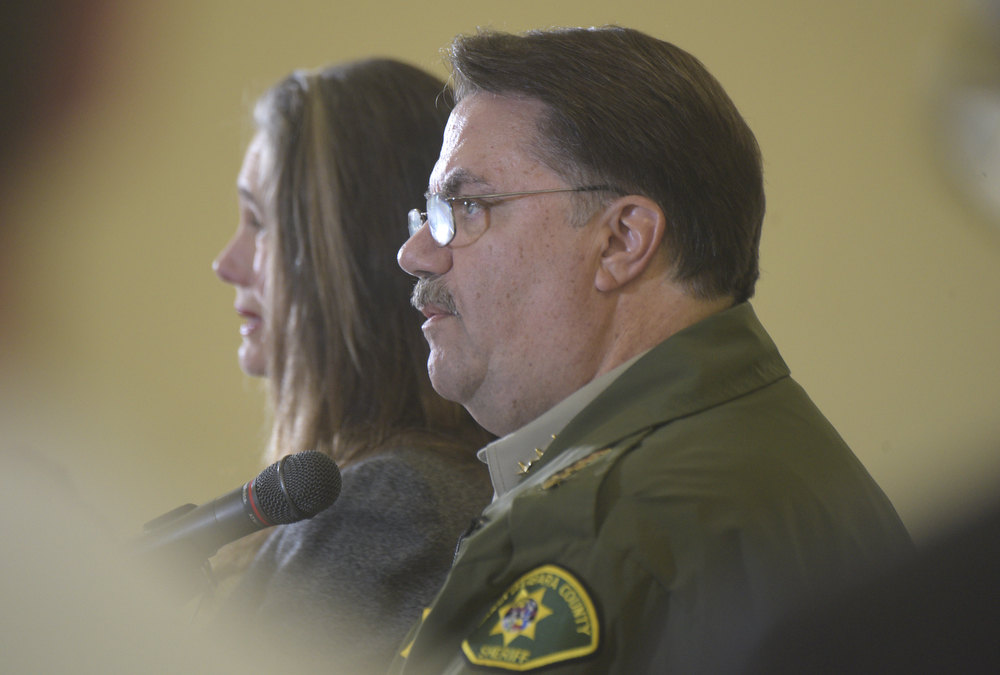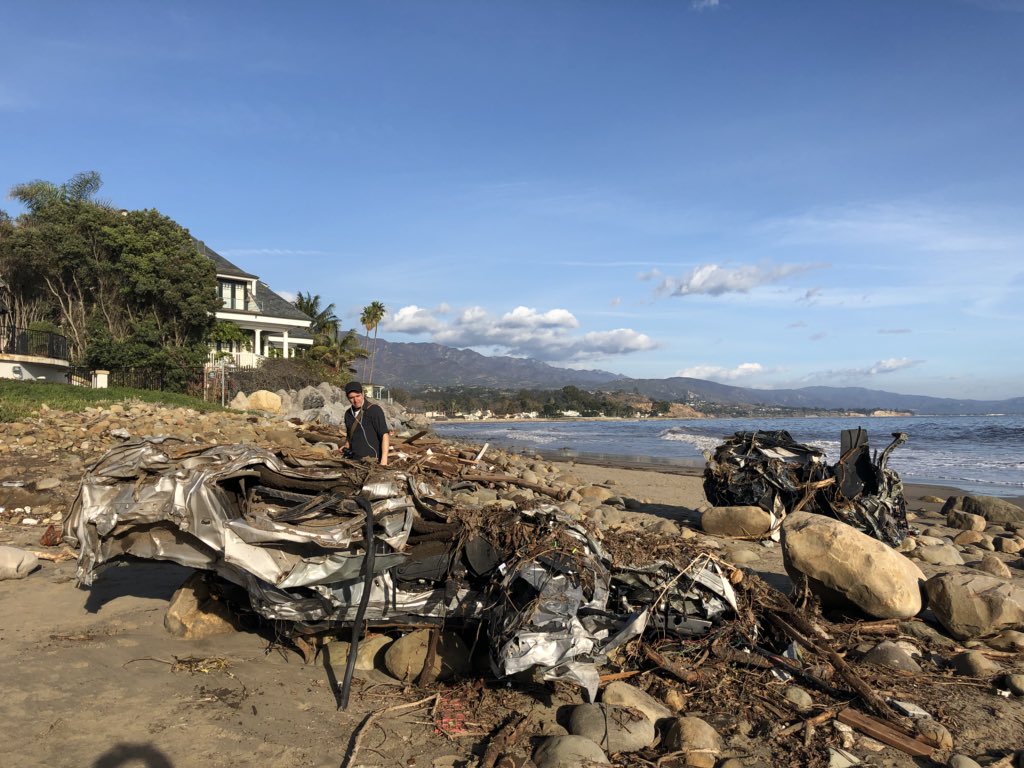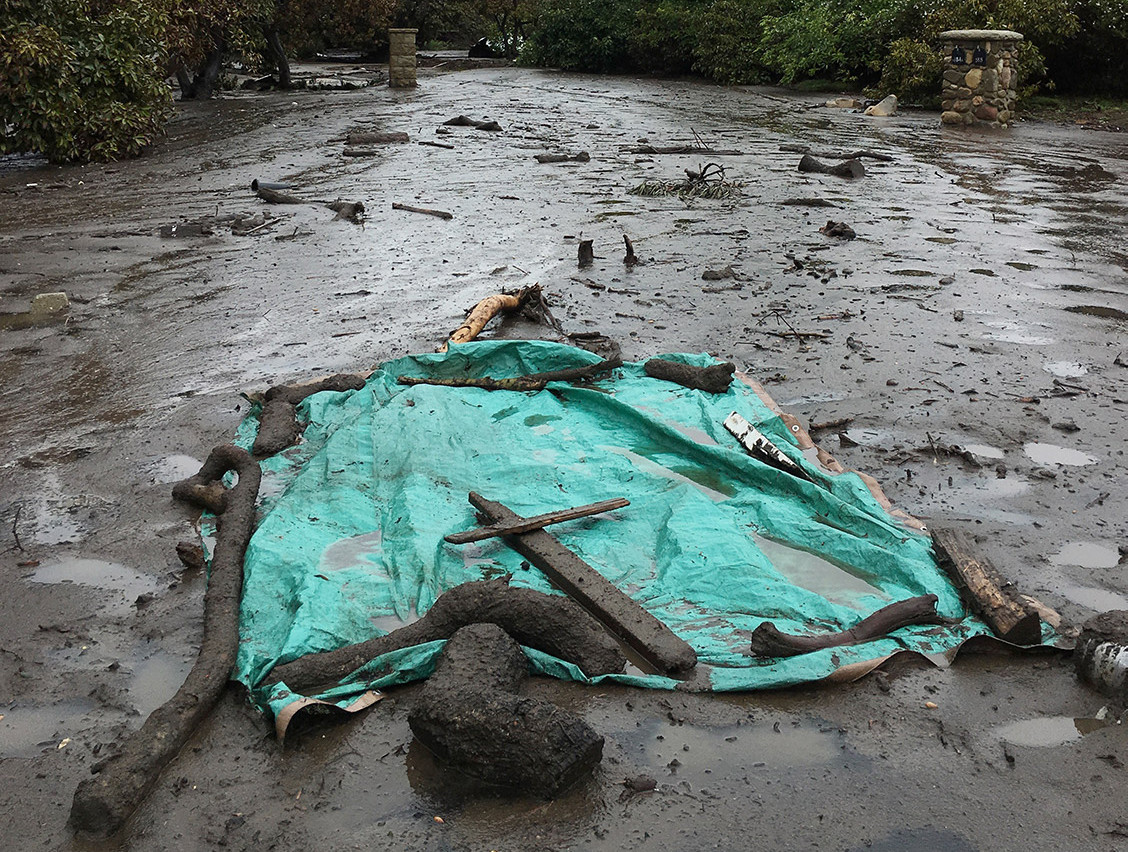As Number of Missing Grows, Questions Arise Over County Warning
First Emergency Cell Phone Alert Was Issued Tuesday Morning After Deadly Flooding Began

Sheriff Bill Brown made the startling announcement Thursday afternoon that the number of people missing in the wake of Tuesday’s devastating Montecito mudslides has swelled to 43. Earlier in the day, authorities had said eight people remained unaccounted for.
Seventeen people are confirmed dead, including four children. Among the adults are a noted hand surgeon, a popular real estate executive, and a college founder. A full list of their identities is published here. All were Montecito residents.
Brown explained the 43 figure includes individuals who are actively missing, as well as those that family and friends have been unable to contact. He said that number may continue to fluctuate.
Brown also announced that the “public safety exclusion zone” that covers most of Montecito and was created to keep bystanders at bay is being upgraded to a mandatory evacuation zone. Car and pedestrian traffic has grown so heavy, he said, that search and rescue and repair efforts are being hampered. “We’re asking everyone in that area to leave,” he said, including residents. The order went into effect at 6 p.m. Thursday evening, ahead of the arrival of more than 100 U.S. Army Corps of Engineers vehicles.
The order will likely remain in effect for a week, possibly two. “We know this is a terribly inconvenient development, but it is also incredibly necessary,” Brown said. The mandatory zone is bounded by the ocean to the south; Hot Springs Road to the west; U.S. Forest Service land to the north; and along Sheffield Drive, East Valley Road, and Ladera Lane to the east. A map of the area is published here.
A boil water advisory remains in effect for the entire Montecito area. Water managers were happy to report, however, that the South Coast Conduit ― the main pipeline artery that draws water from Lake Cachuma down to Montecito and the rest of the South Coast ― is intact. Authorities previously believed it had been severely damaged in the mudslides.
Montecito Water District manager Nick Turner said water service is available at low pressure north of East Valley Road, but supplies are still cut from areas below, as crews work to repair mains and replace hydrants. Turner said it’s unknown when full service will be restored throughout district. “We are working hard, but it will take time,” he said.
Health officials closed all Santa Barbara County beaches Thursday afternoon after fecal coliform concentrations ― generated by untreated storm runoff ― were detected 60 times higher than healthy levels in ocean waters between Gaviota Beach and the south county line. Highway 101 remains shut down between the Milpas Street exit to the north and Highway 150 to the south. The closure is expected to last through the weekend and into early next week.

More than 1,500 responders are conducting preliminary inspections throughout Montecito in search of survivors. Spray-painted symbols on the sides of homes denote whether it’s been checked, where hazards exist, and if anyone alive was found inside. The same communication system was used in New Orleans after Hurricane Katrina. Once the preliminary search is done, which may wrap up Thursday evening or Friday morning, a secondary search will commence, before rescue attempts shift to recovery efforts.
Brown said there’s still hope those trapped may be found alive. “In disaster circumstances, there have been many miraculous rescues of people who had survived for days,” he said. “We’re searching for a miracle now.”
As Santa Barbara County officials remain focused on the search for survivors, questions have begun to bubble over the adequacy of warning notices issued to Montecito residents ahead of Tuesday’s deadly storm, and whether residents were properly notified as soon as disaster struck.
The Los Angeles Times reported this Wednesday that the emergency alert issued by Santa Barbara County’s Office of Emergency Management (OEM) to the cell phones of registered Montecito residents was not broadcast until 3:52 a.m. Tuesday, after the foothills began letting loose violent debris flows that tossed boulders and cars and ripped entire homes from their foundations. The alert came 1 hour and 20 minutes after the National Weather Service (NWS) issued its own cell phone warning of imminent flash flooding in the Montecito area. Eyewitness accounts vary, but some put the start of the mudslides between 3:00 and 3:30 a.m.

In the days leading up to Tuesday’s disaster, county officials issued numerous warnings about the impending rainstorm and its likely ability to trigger significant flash flooding throughout areas destabilized by the Thomas Fire. At a press conference the Friday before, County Supervisor Das Williams described the “very clear and present danger” ahead, and OEM director Robert Lewin described how the fire had compromised 17 major canyons across Montecito and Carpinteria.
Lewin identified “four critical areas” vulnerable to flash floods and mudslides: within the burn scar, immediately outside its perimeter, creekside properties, and lowlands with histories of flooding. He also encouraged residents to visit an interactive map on the county’s website that pinpointed homes in dangerous areas and strongly suggested residents sign up for the county’s emergency warning system, awareandprepare.org.
By Sunday, meteorologists had dramatically increased their rainfall predictions, and all of Montecito was placed either under mandatory evacuation orders or voluntary evacuation advisories. Approximately 7,000 residents lived in the mandatory zone, and another 23,000 in the voluntary area. The county made its notifications through its website, on social media, with local news outlets, and via informational emails. Over 200,000 emails and other warnings were reportedly sent out.
OEM emergency manager Jeff Gater told the Times the county decided not to use the cell phone alert system before the 3:52 a.m. Tuesday notice because officials were doubtful residents would heed the warnings. “If you tell everyone to get out, everyone get out, the next time people won’t listen,” he was quoted as saying. “If you cry wolf, people stop listening.”

Gater was also skeptical in his interview that additional alerts sent Monday night or early Tuesday morning ― when the storm began dumping record amounts of rain on the Thomas Fire burn scar directly above Montecito ― would have prompted more evacuations. “A lot of people don’t listen to their phones when they go to bed,” he said. “That’s why we messaged people on Sunday for something that was 30 hours away.”
Sheriff’s deputies spent all of Monday conducting door-to-door evacuation orders at every home in the mandatory zone. Despite their insistence that residents leave immediately, only 15-20 percent did so. It’s not clear what percentage of residents in the voluntary area, where people were told to pack their belongings and be prepared to flee at a moment’s notice, had evacuated. Many homes were destroyed and a number of people were killed in the voluntary area. Exact figures are not yet available.
Brown said Thursday it was inappropriate to scrutinize the county’s protocols while search and rescue operations were still underway. “There will be an appropriate time when everything will be assessed and we will take a look at what happened,” he said. “Now is really not the appropriate time to do that.” Brown called the Times report a “shame” because it “takes away from the fact that there were extraordinary efforts made to warn the community of this problem.”
Brown defended the timing of the county’s 3:52 a.m. cell phone alert, stating it “was activated at an appropriate time when an event was actually occurring.” He said such county warnings, issued through the federal Wireless Emergency Alerts (WEA) system, which also distributes Amber Alerts, are only meant for actively unfolding incidents, like fires or active shooters. Questions posed to Gater by the Santa Barbara Independent were not answered.
In dismissing the Times report, Brown also noted without further explanation that the article had been amended since its original publishing. The article was published online at 7:40 p.m. Wednesday. The 11:05 p.m. amendment reads: “The headline was updated to reflect that it was the county’s alerts, specifically, that didn’t go out until after the mudslides began.”



